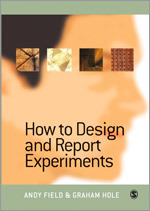How to Design and Report Experiments
- Andy Field - University of Sussex, UK
- Graham Hole - University of Sussex, UK
Research Methods in Psychology
While many books look at the fundamentals of doing successful experiments and include good coverage of statistical techniques, this book very importantly considers the process in chronological order with specific attention given to effective design in the context of likely methods needed and expected results. Without full assessment of these aspects, the experience and results may not end up being as positive as one might have hoped. Ample coverage is then also provided of statistical data analysis, a hazardous journey in itself, and the reporting of findings, with numerous examples and helpful tips of common downfalls throughout.
Combining light humour, empathy with solid practical guidance to ensure a positive experience overall, How to Design and Report Experiments will be essential reading for students in psychology and those in cognate disciplines with an experimental focus or content in research methods courses.
Great book for level 5 undergraduates about to embark on level 6 dissertations.
Great book, however only partially fitting to the course outline.
Nevertheless I could not resist to adopt some examples and even use some of his jokes (of course giving him fully credit for those)
A great book and nicely written. Field once more proves that he is hilariously funny and can even get students reading about causality without getting totally bored after two pages. Students' feedback was overwhelmingly positive.
However, the scope of our course was somewhat broader and therefore we ended up collecting several book chapters and papers in order to assemble a customized essential reader. Therefore only a "recommendation".
Recommended to students as a useful text for the 3 year degree programme
"How to design and report experiments" is an excellent and useful book. It provides clear guidance for analyzing and interpreting data and writing up your research. My students love the funny examples.
"How to design and report experiments" is clearly structured into three parts in order to cover the complete process of experimental research: (1) Designing an experiment, (2) Analysing and interpreting data, and (3) Writing up your research. My personal highlight is part 3, the reporting of findings, which answers questions such as 'What did I find?' and 'So what?'. I can recommend the book to students of all levels.
Nina Jeanette Hofferberth, University of Wuppertal, Germany
A concise and excellent book that covers the basics of experimental design and report. Good for learning about statistics without the need for formula and scary looking symbols. So ideal for an introductory text which fits very nicely with my course.
A concise and excellent book that covers the basics of experimental design and report. Good for learning about statistics without the need for formula and scary looking symbols. So ideal for an introductory text. It also has a section or report writing according to APA format which is very useful.
I would recommend all dissertation students to read this book
An excellent text book. I recommended this book as a secondary text but next year I'll recommend it as a core text alongside the main statistics book.







